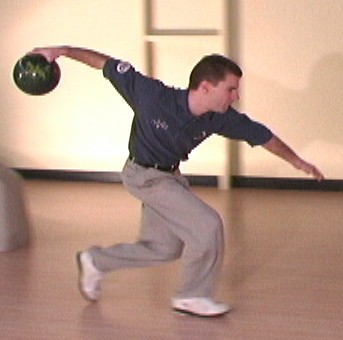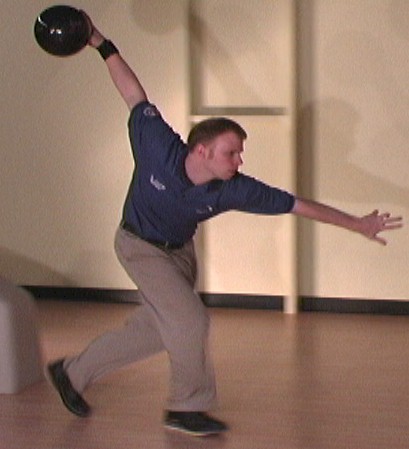
Balance and the Balance Arm
Great balance is essential to great shot making. But how do we achieve great balance? Some of this comes from the balance arm, and the way to do it differs from how it was thought to be best in the past.
When you let the ball drop into the swing, you want to point your balance arm more forward than to the side. Think about walking down the street and swinging your arms. When you walk down the street, your left arm naturally goes forward as your right arm goes back. For a right-handed bowler, the same should be true. As you drop the ball into the swing and your right arm starts to swing back, the left arm should move forward. How should it move forward?
If you are a right-handed bowler bowling on lane 4, look at the left-hand gutter cap on lane 3. Now, stand in your starting position and point your left hand toward that gutter cap with your thumb pointed down. Once your drop the ball into your swing, always keep your left hand pointed to this position throughout the swing. If you do this, by the time your body reaches the foul line, your left hand will be pointed to the wall, and your shoulders will be perpendicular to your target line. Fundamentally, make sure the balance hand is pointed forward, is kept low (ideally at about waist height) and slightly left until you reach the top of the backswing.
So, what does this motion accomplish? First, it is easier to move your shoulders if you move the left hand forward as your right hand moves back. Second, this motion creates an arm slot where the ball travels directly under your head and shoulder during the swing. Third, this motion allows your trunk to turn a little bit, which creates a torque and power that you can turn into leverage and revolutions at the bottom of the swing. Why are power players more accurate than you might think? If you watch a Tommy Jones or a Jason Couch, you will find that they are much more accurate than you would think at first glance. Yes, the revolutions on the bowling ball create natural mistake area to the outside of the lane. But Tommy Jones won the U.S. Open, didn’t he? Isn’t this the toughest condition that most tournament bowlers ever face? If you watch these players in slow motion, you will see the balance arm forward, the trunk turn slightly in the backswing, and the return to a square release point, albeit with the bowling shoulder lower than the balance arm shoulder. They can hit a target line because the swing stays under the head and goes in a straight line. So, to create a good arm slot, move the balance arm forward as the ball-side arm moves back toward the top of the backswing. It is key to keep the thumb pointing down, as this will prevent you from moving the arm back past your shoulders in the downswing. If you are still not sure of this, try this simple test. First, stand up and stick your balance arm out with your thumb pointed up. Now, move your arm back as far as you can. Next, do the same thing with your thumb
pointed down. You will find that as your hand gets to be even with your shoulders, you will feel resistance – the biomechanical effect of how our bodies are constructed.

Let’s take a look at Master’s champion Jason Queen at the top of his backswing. In this picture, you can see that Jason’s balance arm is forward and roughly pointing towards the left gutter cap on the next lane. You can also see some “torque” in the trunk of Jason’s body. This allows him to create leverage and good roll at the bottom of the swing.
Of course, with a player like Tommy Jones, this effect is somewhat more noticeable, since the higher backswing results in more torque of the trunk. You can also see roughly the same positioning of the balance hand at this point.

Finally, note that with both players, they still maintain balance by keeping the lower body underneath their shoulders. Balance comes from the proper use of the balance arm AND keeping the lower body beneath you to create great balance.